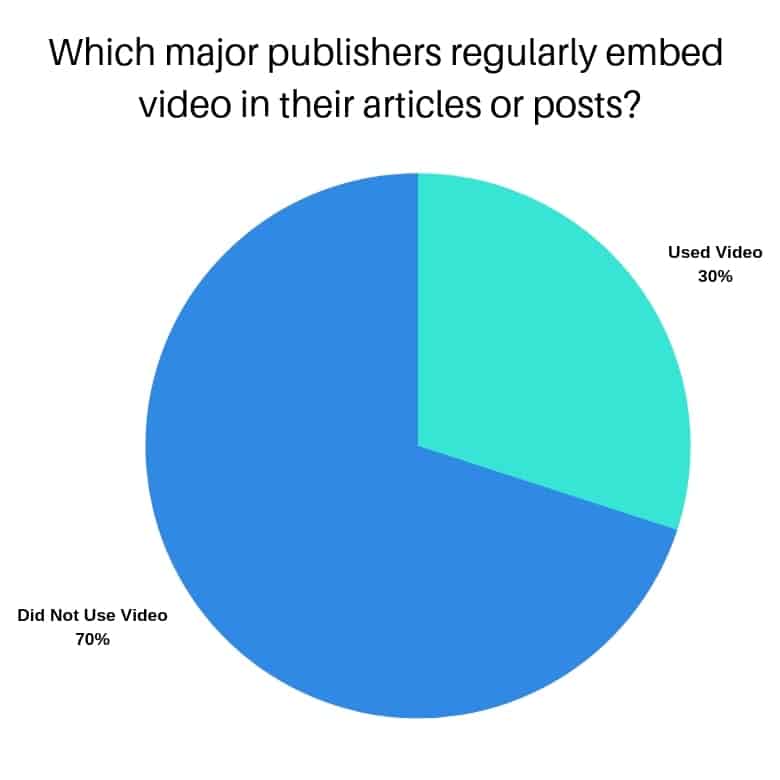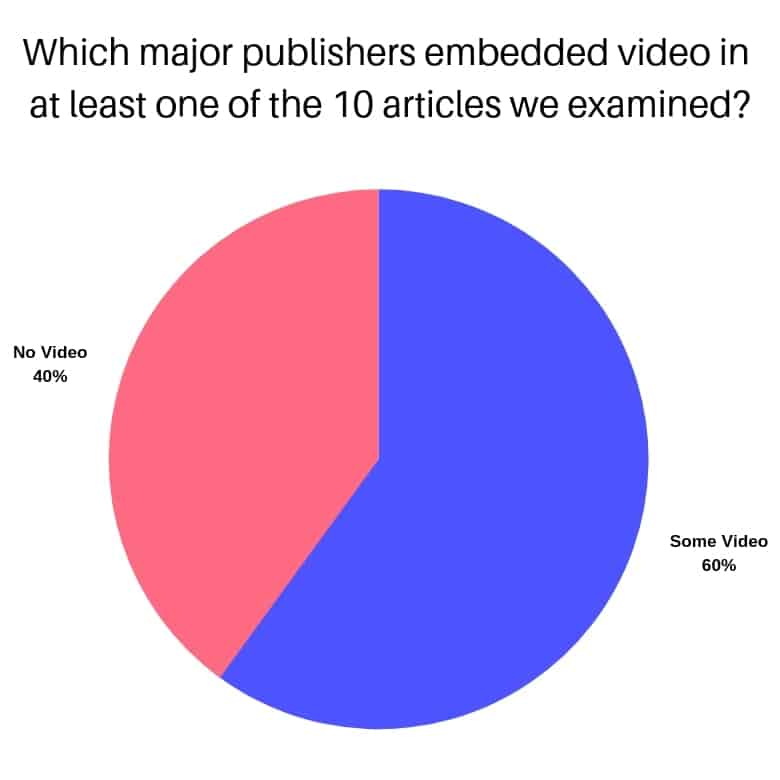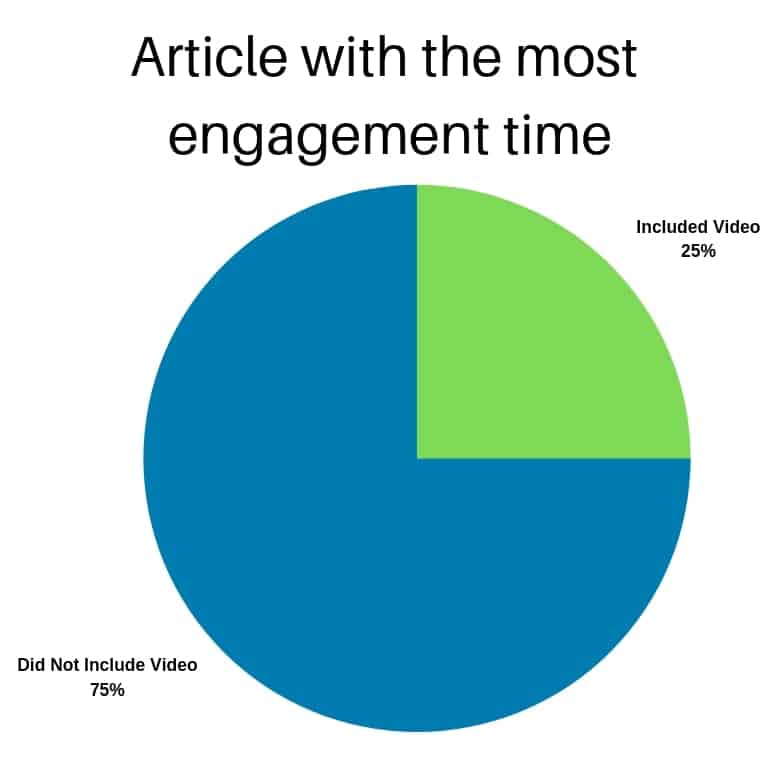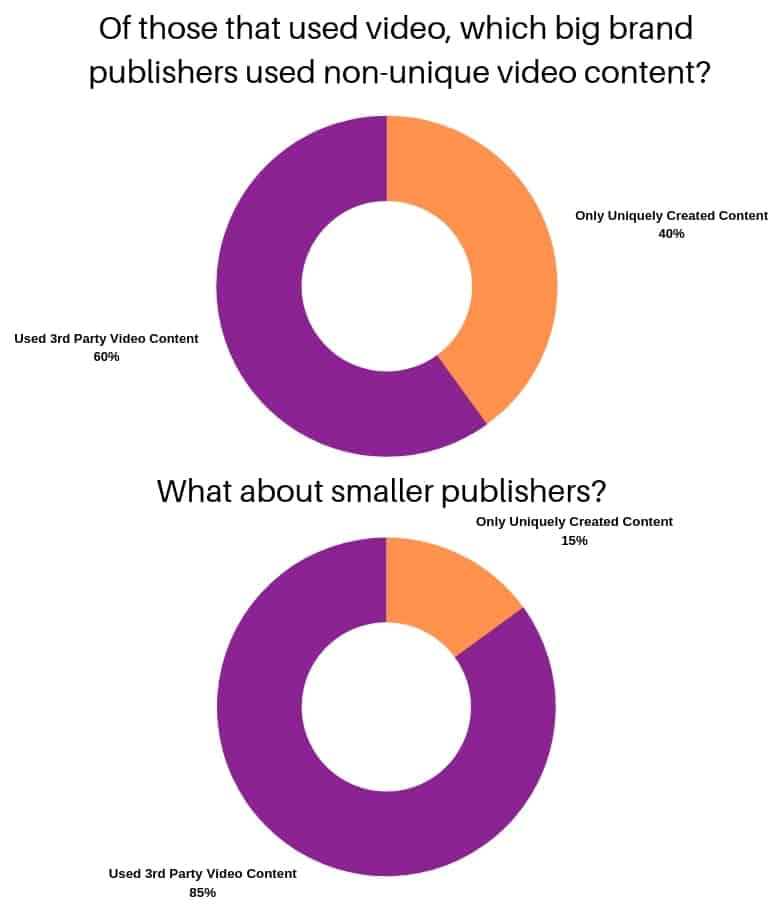Stats On If You Should Embed Video In Posts To Increase Engagement
How do readers or visitors prefer to get their content? Every website’s audience is different. In fact, pretty much every type of visitor is different. What one visitor prefers another visitor might hate. Most publishers understand this paradigm, and for this reason, many are left wondering what role video content should play in posts or articles they publish.
Should you embed video in posts or other content? That seems like more work, right? What if you embed someone else’s video? Will readers appreciate that or see it as an unnatural fit into your unique content?
These are important questions for publishers to ask. Should you be doing video, embedding video, or using video in any way on your site?
What you’ll find below:
- Stats and charts of publishers using embedded video
- How embedded video impacts revenue, SEO, and engagement
- How these publishers are using video content
Are large digital publishers embedding video?
Often, publishers will look to market leaders for direction on questions like this. If the big brands are investing in video, there may be some merit there, right?
That made us ask the question, “how many brand publishers embed video in the majority of their articles?”
| Publication | Regular Video Embedment (Y/N) | Comments |
| Wired | No | 0/10 articles opened had video |
| The NY Times | No | The articles that did have videos were still very text heavy – Video was the supplemental content |
| Vice | No | 1/10 articles opened had a supplemental video |
| Forbes | No | 1/10 articles opened had a supplemental video |
| Buzzfeed | No | 2/10 articles opened had supplemental videos |
| Gizmodo | No | 0/10 articles opened had video |
| Inc. | No | 0/10 articles opened had video |
| LA Times | No | 0/10 articles opened had video |
| The Spruce | No | 0/10 articles opened had video |
| Men’s Health | No | 1/10 articles opened had a supplemental video |
| Vox | No | 2/10 articles opened had supplemental videos |
| Matha Stewart | No | 0/10 articles opened had video |
| Bloomberg Businessweek | No | 0/10 articles opened had video |
| Uncrate | No | 0/10 articles opened had video |
| USA Today | Yes | The main portion was a video with supplemental text and images |
| Yahoo | Yes | Text-heavy, videos are supplemental |
| ESPN | Yes | The main portion was a video with supplemental text and images |
| CNBC | Yes | Text-heavy, videos are supplemental |
| National Geographic | Yes | Text-heavy, videos are supplemental |
| Cosmopolitan | Yes | Light on text, but heavy on video and images |
You can see a list of publishers we examined and the results of the research in the table above. Additionally, you can scope out the comments to see just how each of the publishers is using the video content.
It should probably not come as a major surprise that the majority of publishers are not regularly embedding video in their articles or content. However, if we look closely at the information, we can see that the majority of publishers actually did use video in at least one of the articles we reviewed on their site.
You can see that it is common for these publishers to use video as a supplement to some of their text content.
Does embedding video help with audience engagement?
Personally, I don’t usually watch the video that is embedded in articles. However, for many readers, this is their preferred method of consuming content. It’s really important we don’t bring our personal bias into how we evaluate the way an audience might behave.
We looked at 20 publishers using the Ezoic platform — of different shapes and sizes — to try to better understand the relationship between video and engagement time.
| Publisher’s Monthly Pageviews | Article With Most Engagement Time Included Video |
| 500,000 | No |
| 1,000,000 | No |
| 1,500,000 | No |
| 200,000 | Yes |
| 150,000 | No |
| 12,000,000 | No |
| 3,700,000 | No |
| 70,000 | No |
| 45,000 | No |
| 1,000,000 | Yes |
| 4,500,000 | No |
| 3,400,000 | No |
| 450,000 | Yes |
| 50,000 | No |
| 1,200,000 | No |
| 600,000 | No |
| 7,500,000 | Yes |
| 300,000 | No |
| 35,000 | Yes |
| 6,500,000 | No |
Engagement Time is the time recorded when website visitors are actively looking at a web page and interacting with it, but it excludes when users are quickly scrolling, waiting for a page to load, searching through navigation, or in other windows or tabs.
It is really the minority of publishers that saw their highest article engagement time on posts that included video content.
Of the 5 publishers that had video content on their article with the highest engagement time, all 5 included a video that was unique and created by the publisher themselves.
What does this mean?
While still a small sample size, it suggests that if article engagement is the target of including more video, that publishers should probably strongly consider creating their own unique video content to support the article or post.
Does embedding video help with monetization?
Other than audience engagement, one of the primary drivers for adding video content to a page is monetization.
Publishers can monetize the video inventory, on top of the ad inventory already on the page, when they use video. Self-hosted videos that are served by the publisher through a 3rd-party video player (like JW Player) offer some of the greatest ability to maximize the revenue for video content; however, they are not always easy to set up, can be expensive to implement, and don’t offer the platform searchability that platforms like YouTube offer.
That said, do articles with video on them make more money than those that don’t?
| Publisher’s Monthly Pageviews | Landing Page With Highest Session Revenue Included Video |
| 500,000 | No |
| 1,000,000 | No |
| 1,500,000 | No |
| 200,000 | No |
| 150,000 | No |
| 12,000,000 | No |
| 3,700,000 | No |
| 70,000 | No |
| 45,000 | No |
| 1,000,000 | No |
| 4,500,000 | No |
| 3,400,000 | No |
| 450,000 | Yes |
| 50,000 | No |
| 1,200,000 | No |
| 600,000 | No |
| 7,500,000 | Yes |
| 300,000 | No |
| 35,000 | No |
| 6,500,000 | No |
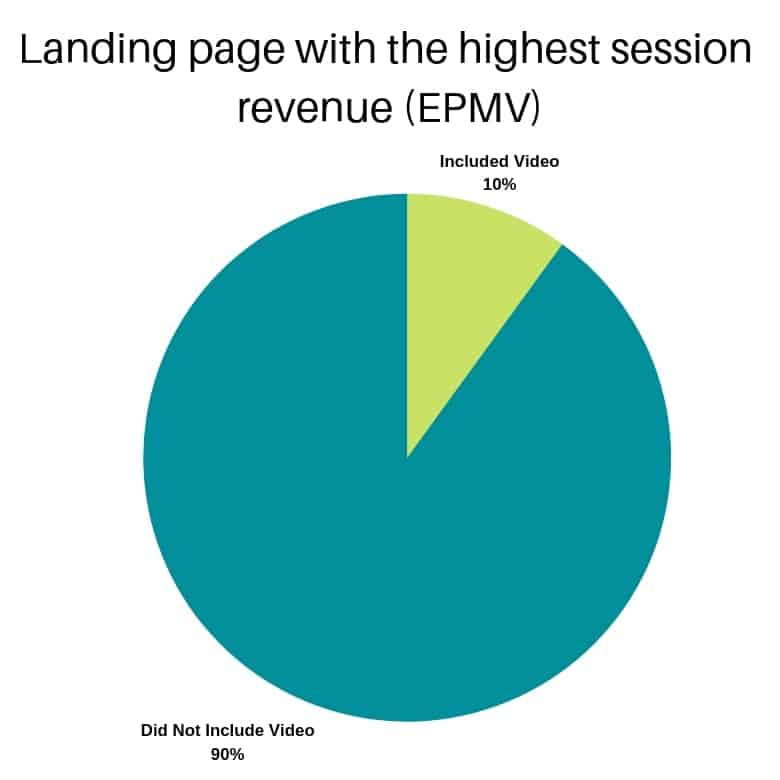
Of the Ezoic publishers we looked at in this small sample size, the vast majority saw their highest earning articles — in terms of session revenue — come from articles that did not include embedded video.
This is not an indictment on video. Many of the publisher sites we reviewed had very high earning articles that did include embedded video. They just weren’t the highest earning articles on the site. This simply demonstrates that it is not a black/white question.
Video can allow publishers strong opportunities to increase engagement and article revenue, but it is not a blanket strategy that works for every site … or even every article on a site.
How are publishers hosting or embedding videos?
The vast majority of the big brand publishers listed in the first table above use self-hosting, 3rd-party video players to embed their video content in articles.
However, most of the publishers that we studied on the Ezoic platform used a major video platform to host and embed their videos on their sites. Below, you can see which platforms were the most popular.
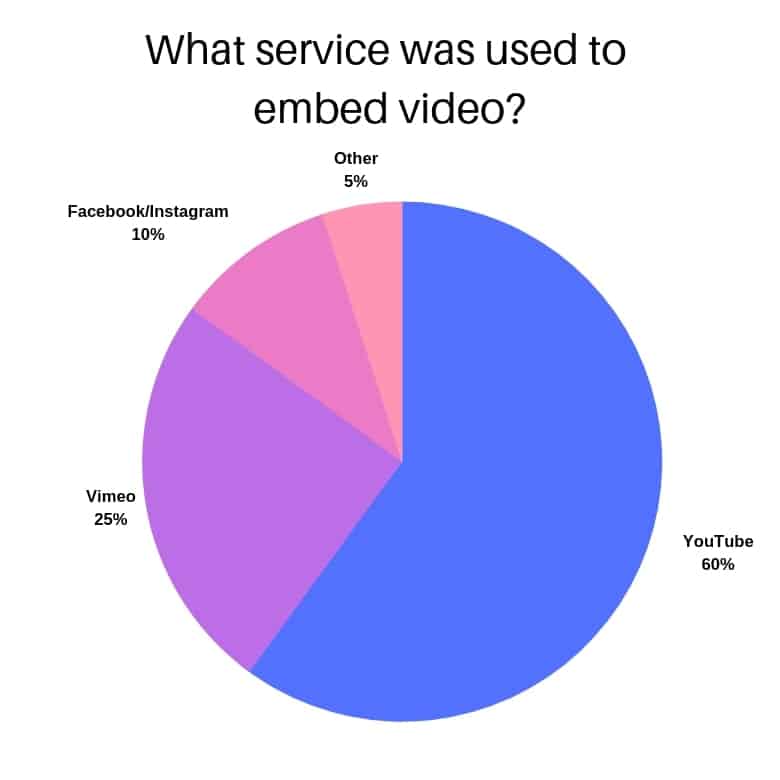 It comes as no surprise that YouTube was the most popular form of integrating video into articles for the majority of publishers we looked at. The major brands have the resources to invest in their own video players and often have separate teams in charge of managing growth on platforms like YouTube.
It comes as no surprise that YouTube was the most popular form of integrating video into articles for the majority of publishers we looked at. The major brands have the resources to invest in their own video players and often have separate teams in charge of managing growth on platforms like YouTube.
YouTube gives publishers an opportunity to double dip. This means publishers can grow an audience on the YouTube platform and hopefully direct them back to their site, or potentially monetize the engagement on that platform for what it’s worth. At the same time, publishers can embed the video on their sites to increase engagement and potentially improve revenue there as well.
The same can be said for social platforms like Facebook and Instagram. Using the video capabilities of these platforms allows publishers with sharable content to create greater interaction between their social following and their on-site experience.
For publishers experimenting with the idea of doing more video content, leveraging one of these platforms to get started offers a lot of flexibility and upside.
Unique video content vs. 3rd-party content
Creating video merely to support the text in the article can end up feeling like a big investment of resources. If the ROI of this is unclear, publishers may look to find ways to add video to their articles without the requirement of creating the content themselves.
A lot of publishers have chosen to embed video content from YouTubers or other 3rd-parties as a way of adding the value of video without the cost of production.
While these types of video content certainly have their detractions, you may be surprised to learn how many big brand publishers embedded outside video on their sites.
Again, we can come away with the fact that there are no hard and fast rules as to what a publisher should or shouldn’t do. It really comes down to finding the right tool for the right job.
Many publishers that do not plan to use a video beyond embedding it an article elect to embed someone else’s video in their article to improve the reader’s experience.
It appears that when the publisher has really unique content, or the ambition to use the video content on a platform outside of their site, it often makes more sense for them to create the content themselves.
Does embedded video affect SEO?
Like most questions with SEO, it comes with a number of caveats. That said, consider this… if the video improves the reader’s experience (length of session, pageviews per visit), the answer is likely… yes, it is good for SEO.
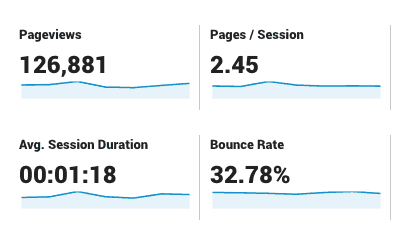
SEO considerations when embedding video:
- You can use rich data mark-up to highlight unique video content (which may help the article rank higher)
- Videos embedded from outside platforms could potentially slow down the page
- That isn’t always a bad thing as long as it doesn’t dramatically impact those metrics above
- 3rd party video is outside of your control, so recommended content, or ads that show on those videos, could deter your audience
- Regularly check to ensure your embedded videos still work, they can impact an article negatively if they go down and you don’t know it
- Having a video that lives on YouTube has been shown in some small studies to lead to more backlinks over time from other sites
Should you embed videos in your content?
Publishers should be asking themselves a number of questions about video before selecting a strategy.
How do visitors react to embedded videos in the content?
Do 3rd party videos perform as well as unique videos on your site?
Do you have the ability to scale content on YouTube and attract a larger audience?
What is the resource commitment neccessary to do all these things effectively?
These are the questions publishers should be asking. There is not one answer for everyone. In fact, there might not be a single answer for all the pages on your particular site or property.
I recommend testing embedded video to see how well it improves things like audience engagement and monetization on your site. You can monitor both of these metrics really well alongside your video content using Ezoic’s free publisher analytics tool, Big Data Analytics.


